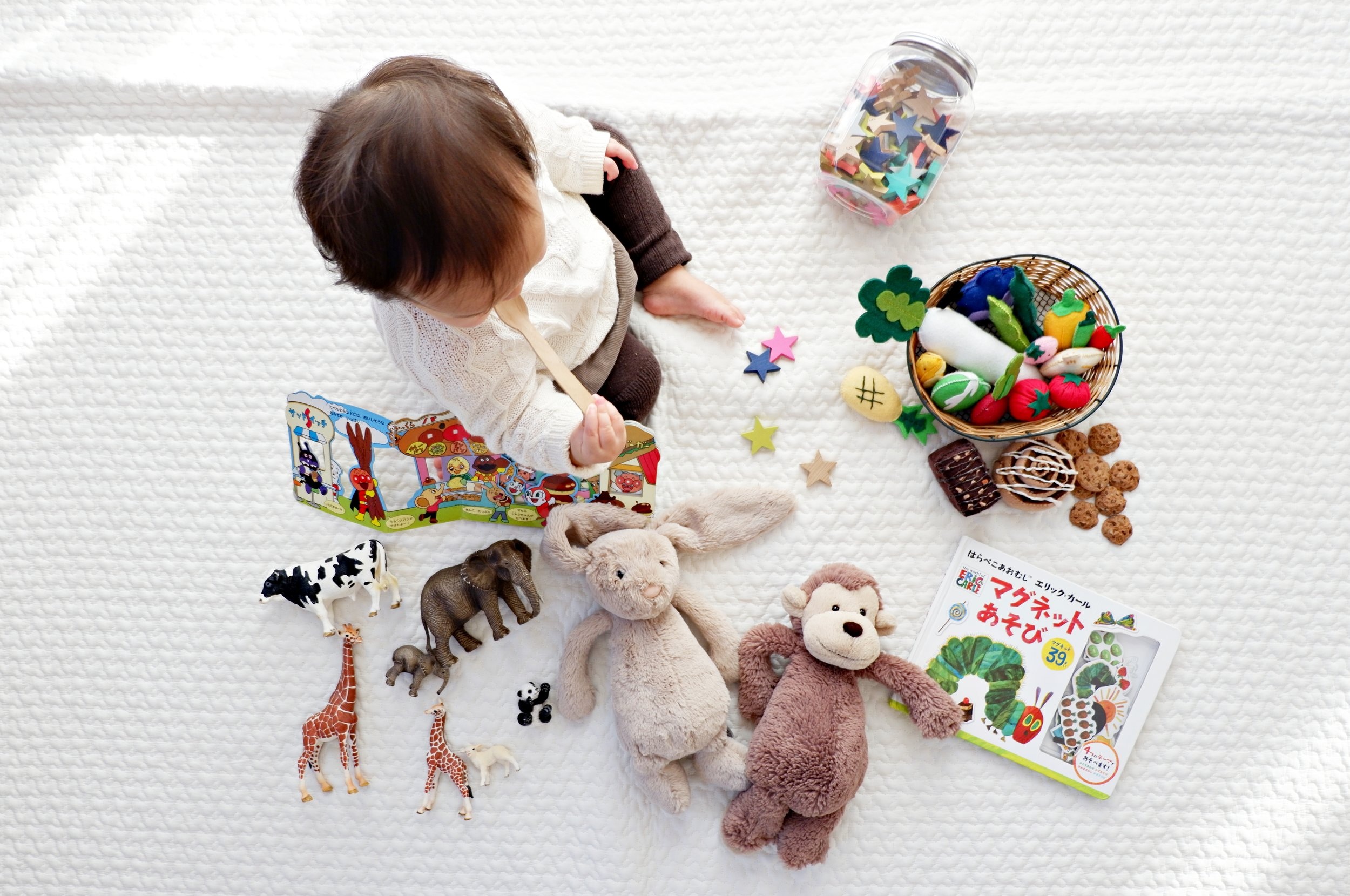Do you Know the Most Important Rule about Toys in Preschools?
You’re at your desk working on a report. You realize that this report would be 10,000 times better if your first topped off your coffee. You go to the break room and top up your coffee cup. Perhaps along the way you stop to chat briefly with a coworker. As you make your way back to your desk, you notice that someone else is sitting there, working on your computer and chewing on the lid to your favorite pen (don’t we all have those?). Naturally, you go over and ask them to move. They completely ignore you. Your boss walks by and notices the situation. You share what happened and your boss tells you “well, you weren’t there and you weren’t using it. Go find another desk”. What?!?!?!?
Welcome to a day in the life of a preschooler ;-). It’s confusing and daunting.
Figuring out the unwritten rules for who is using an object and what items are available for play is a formidable task. In the desk example, it seems ridiculous to consider that someone could possibly think they could use *your* desk simply because you weren’t sitting at it! But in the preschool setting, that’s the norm. Every day children are frustrated and confused when others take *their* items just because they weren’t using them. Luckily, we’ve broken this process down into one simple, visual, and concrete rule.
What are the Preschool Rules?
As play changes and develops, so do the rules for who is using an item. For young children (until the age of around three years six months), the general rule of thumb is that if an object is in your hands - you are using it. This means that if an object in unattended, it is fair game.
The challenge with this rule is that it’s not written down anywhere or actually *explained* to anyone. As a result, children who struggle with social (pragmatic) language often find themselves on the receiving end of what they perceive to be unfair outcomes (and around here, we *always* consider the child’s perspective). Children are asked to return items that they believe they were using and children are told that something they want is now no longer a choice.
All of this confusion can be solved by actively teaching children the rule about toys ‘having hands’. Teaching children about toys ‘having hands’ adds concreteness to this abstract concept. As an added bonus, thinking about a toy ‘having hands’ helps children keep track of what items they’re telling the world they are using.
So what is this magical rule?
The Toys Have Hands Rule
The rule is simple - so simple that once I explain it to people (parents, teachers, and children alike) they all wonder why it seemed so complicated in the first place ;-).
If an item is attached to a hand, it is in use. If an item is not attached to a hand, it is free for someone else to use. That’s it!
Applying the ‘toys have hands rule’ to your workplace conundrum, as soon as you walked away from your desk, your computer and pen no longer ‘had hands’ attached. According to preschool rules, those items no longer belonged to you and were free for anyone else to use. In the young preschool environment, this is largely the rule that children follow. If you walk away from a bike, that bike is free for someone else to use. You put down a car, it’s fair game for any other child in that center. This doesn’t begin to change until children start engaging in more collaborative and group play/building (around 3 years 6 months). And even then, those rules only shift slightly for collaborative play based centers (ex: blocks center, home living).
How do I start teaching about toys having hands?
While the rule is simple, we do recommend first taking some time to teach some background information and some additional steps. We’ve outlined the process we follow below:
1. Build background knowledge
It’s important for everyone to understand the concept behind the rule - why we use the words that we use and how it’s helpful for everyone involved. When people know better, they do better! We use the word ‘hands’ since a child’s hands are the most likely body part attached to the object/item. In reality, it’s any body part that is using the item.
Increase everyone’s overall awareness of our hands and what they can do:
Start by noticing your hands. Notice that everyone has their very own set of hands.
Share that each person is in charge of their own hands and what their hands do.
Practice different actions you can do with your hands (waving, clapping, shaking).
Notice that different people can do different things with their hands. Have different children do different actions to emphasize that each person is ‘in charge’ of their own hands and can choose to do different things.
Explain how ‘hands’ are involved with objects and play:
Notice that when we’re holding something, our hand is now ‘attached’ to that item
Because our hands are attached to the item, that toy now ‘has hands’ - this tells people that we are using that item.
Look for toys with no hands or additional body parts attached - this tells people that no one is using that item. If we wanted to play with it, we could go over and pick it up/use it.
2. Practice, practice, practice
We cannot stress enough the importance of repeated and structured practice. This is a new skill that we are expecting children to learn. I don’t know about you, but anytime I try to learn something new, it takes me multiple attempts. If that’s the case for grownups, why would we expect anything less from a child? The good news is there are oh so many ways to practice ;-).
Structured practice:
Gather some toys! You’ll need enough items for each person to have one item and for there to still be some leftover.
Place some toys on the floor/a table.
Give each person one toy.
Encourage everyone to look at a toy (ex: look at the firetruck).
Decide if the firetruck ‘has hands’ or the firetruck has ‘no hands’. We like to use the script “Does the _____ have hands or no hands?”.
Remember, we’re still teaching the concept of something ‘having hands’ so this may still be confusing. If children are struggling, add in additional support: “I see Jacob’s hands are holding the firetruck”. “Jacob are your hands touching the firetruck?”.
Discuss what it means to have hands or no hands:
If a toy ‘has hands’ it is being used by someone else.
If we want that item we can ask for a turn and the person using it can tell us ‘yes or no’. We like to consistently use the script “____ has hands”. That means name is using it. If you want it, you can ask for a turn and name can tell you ‘yes’ or ‘no’”.
If an item has ‘no hands’ it is free for us to pick up and use (stay tuned for our follow-up on what to do when this rule shifts and/or if someone protests the use of an item with ‘no hands’!).
3. Embed practice and reminders into your daily routine
Once you’ve discussed the general concept and done some practice sessions, start embedding use of the concept into your daily routines and conversations. This is a great way to notice if children are starting to understand this concept or if some additional structured teaching is required.
When encouraging children to find toys/materials, remind them they’re looking for something with ‘no hands’ - “Let’s find a bike with no hands to ride”. “We’re looking for a bike with no hands”.
If a child requests something that is currently in use, notice that it ‘has hands’ and so we will need to either ask for a turn (remember, the person using the toy can say ‘yes’ or ‘no) or we can find something else:
“I see the dinosaur has hands - Larissa’s hands are holding it. Would you like to ask Larissa for a turn or should we look for another dinosaur?”.
Before a child moves away from an item you know they enjoy, check in to ensure they understand what this is telling others
“I see you put down the bucket. The bucket now has ‘no hands’. That’s telling others you’re done with the bucket. Are you still using this bucket or were you finished?”
Don’t forget, just because a child can repeat the rule to you verbatim doesn’t mean they are yet able to actively apply the principle in practice. Think back to when you were learning to drive, you could explain the process, you needed to pass the theory test first, but you still weren’t able to actually drive on your own without a lot of practice. Developing new skills take time, structured and repeated practice, productive feedback, and patience.
Let me know how you’re using this strategy in your home, therapy setting, or classroom! Follow my blog below so we can stay in touch :-)



